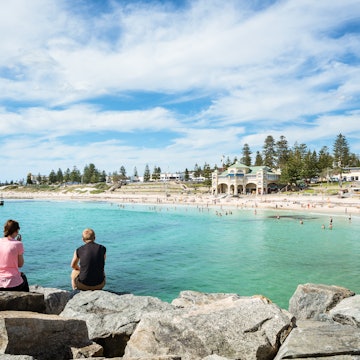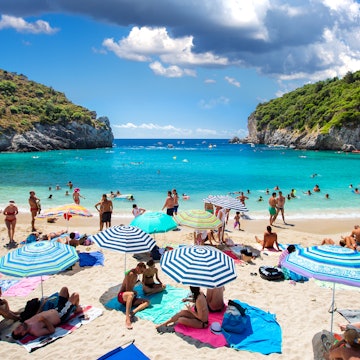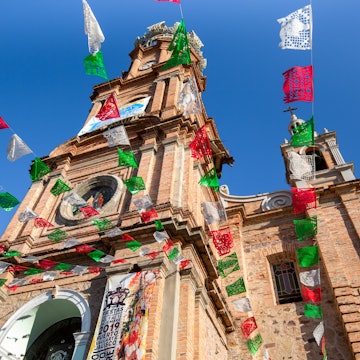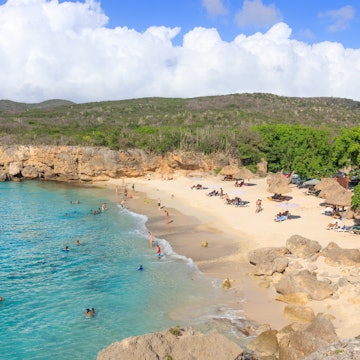
Van camping responsibly: what you need to know before hitting the road

Nov 5, 2019 • 7 min read

Camping at designated sites is fairly straightforward, whether you're in a tent or a van. But keeping it clean while backcountry camping takes a little more initiative. © Britany Robinson / Lonely Planet
When I was traveling in my camper van, I had access to pockets of the world I might never have discovered otherwise. Bumpy dirt roads meandering through public land were the entryways to quiet pockets of wilderness where I could find a place to park. In the morning, I’d wake up surrounded by nature that felt mostly untouched.
Of course, it wasn’t untouched. I was there, making an impression with both my human and large vehicle footprints: driving with headlights cutting through the dark; parking just off the dirt road where my tires pressed into the earth; walking around with my dog; and leaving unavoidable, literal footprints all over these wild places. Despite occasional solitude, more campers had come before me, and more would come after.

This secluded image of van camping has inspired waves of people to embrace “van life.” Some are moving into vans full-time. Others are renting them for a weekend or a cross-country road trip. All of them will have the option to camp at established campgrounds or "boondock" further away from crowds and facilities. Van camping can offer access to special places, but with that access comes big responsibility.
First things first: Every responsible camper should know and understand how to “leave no trace.” The Leave No Trace Center for Outdoor Ethics outlines 7 principles all campers should read and understand. But when it comes to responsible van camping, there are some additional details to help you roam respectfully.

Educate yourself on the places in which you’re camping
If you’re trying to escape the crowds, you might find yourself camping where there are no posted rules, no park rangers, and no one to explain the significance of, say, the cryptobiotic soil you could be trampling in the desert while searching for the best place to watch a sunset. (Cryptobiotic soil is a living crust of earth, created by algae, cyanobacteria and fungi — it’s vital to the health of certain ecosystems, and does not like to be walked on.)
Prior to venturing out to camp with your van, visit the nearest ranger station, visitor center, or public park where knowledgeable rangers can provide important information about the place you wish to explore. Ask questions about wildlife, the local ecosystem, any necessary permits in the area, and the best places to park.
Read up on the nature of the place you’re visiting. You should know what type of wildlife might be present and what vulnerabilities exist between you and the local ecosystem.
Related: The best destinations for camper van travel
Meet the couple who never leave home without their abseiling dogs
Bring a paper map — you can pick them up at the local ranger station or nearby shops. Hard-copy maps will give you an overview of where you are and where you’re headed, even when there isn’t cell service or your GPS runs out of power. By knowing and planning for the places you’re visiting, you can stick to your route, camp on durable surfaces, and minimize your impact on the place you’re traveling through. When camping, try to park in spots where someone has parked and camped before, rather than create a new site.

Know your waste and how to handle it
Camper vans were designed to carry many of the comforts of home. That means they also can carry more waste than you might create while camping in a tent. There are various ways to properly contain and dispose of waste, depending on where you’re van camping and what facilities you have available. That's why it’s so important (and sometimes confusing) for responsible van campers to understand the correct practices.
Amanda Winther of The Van Project has been living in a camper van for three years. Readers often ask her for advice on grey and black water disposal. Gray water is the dirty water from brushing your teeth, washing yourself, your dishes, etc. It might seem harmless to dump, especially if you’re using biodegradable soaps. But gray water can still attract wildlife and pollute natural water sources.
“The best option is to always strain and collect your grey water and carry it and all other waste out with you,” says Winther. “If you want to dispose of grey water or pee (from compost toilets or pee jugs) outside, use the LNT rule and scatter it (instead of pouring in one place) at least 200 feet, approximately 70 paces, from your campsite, water, trails, or roads.”
Black water, on the other hand, is what collects in your camper van's toilet (if you have one). Unlike grey water, black water should only be disposed in RV sanitary dumps. If you don’t have your own toilet, you’ll have to deal with how to properly dispose of human waste.
“Use a toilet whenever it’s available,” advises Winther. But if you're going beyond the reaches of modern plumbing infrastructure, or your van doesn’t have a loo on board, there are steps you can take to minimize the impact of your number two. First off, it’s a good idea to make a pit stop before you venture out.
Beyond going before you go, prepare to properly dispose of waste when there is no toilet – because you can’t always plan for when you gotta go. In some environments, it’s acceptable to bury your waste in a cat hole (a hole about half a foot deep dug specifically as a single-use latrine). When in doubt, refer to the detailed instructions Leave No Trace offers on how to bury human waste. But in sensitive or high-traffic destinations, it’s better to carry it out with you.

Every van camper should have a way to pack out human waste for those places where burying isn’t an option. Maybe you’re in a cold or rocky spot where the earth is too hard to dig a hole, or a marshy area where you can’t get 200 feet from water. Perhaps you're hiking on a highly exposed trail where you can't veer off course to do your business.
That's when you need a WAG bag. WAG bags (technically short for Waste Alleviation and Gelling) are convenient “portable toilets,” that include toilet paper and hand sanitizer. You poop right in the bag, where a gelling compound neutralizes odor. Then seal it all up and dispose of your wag bag at a designated human waste dumpster. You can also carry a makeshift wag bag or “toilet kit” with a sealable bag, a trowel, toilet paper, and hand sanitizer. Just make sure whatever you’re using seals tight.
Human waste isn't the only detritus you need to contain, however. I’m a pretty organized camper, but when I was living and camping in my van, the clutter accumulated. Gum wrappers, parking stubs, grocery lists, and the little plastic corners of chip bags floated around my home on wheels. It’s easy to forget how easily these things can fall out of your van.
Responsible van campers should try to minimize the trash they produce and carry into nature. Buying food in bulk with reusable bags, keeping small personal items secured in reusable containers, and generally keeping an eye out for small pieces of waste will all help to minimize your impact and keep it out of the environment.

Connect with van communities that will help you be more responsible
People have been van camping for decades. If you’re new to this method of exploration, it’s helpful to lean on the knowledge gathered by those who have come and gone before you. If you don’t know, ask!
Experienced, responsible van campers are constantly sharing advice and answering questions on blogs and through online communities. If you are committed to responsible van camping, then there is a community who will embrace your curiosity and help you do it better.
The Vanlife App has a mission “to make vanlife sustainable.” They offer resources, online community, and events to help inform more responsible van campers.
Several Facebook groups with active van camping communities include The Vanlife Campfire, Solo Women Van Dwellers, and Vanlife Diaries Social Forum.
You can even meet up with fellow van campers in person. Vanlife Diaries hosts regular events with workshops, conversations, and demonstrations that cover many of the skills and challenges of responsible van camping.
Even experienced van campers should keep an open mind to improving their responsible van camping practices – no one knows it all. So keep connecting, keep camping, and keep striving to be kind to the places you visit.













